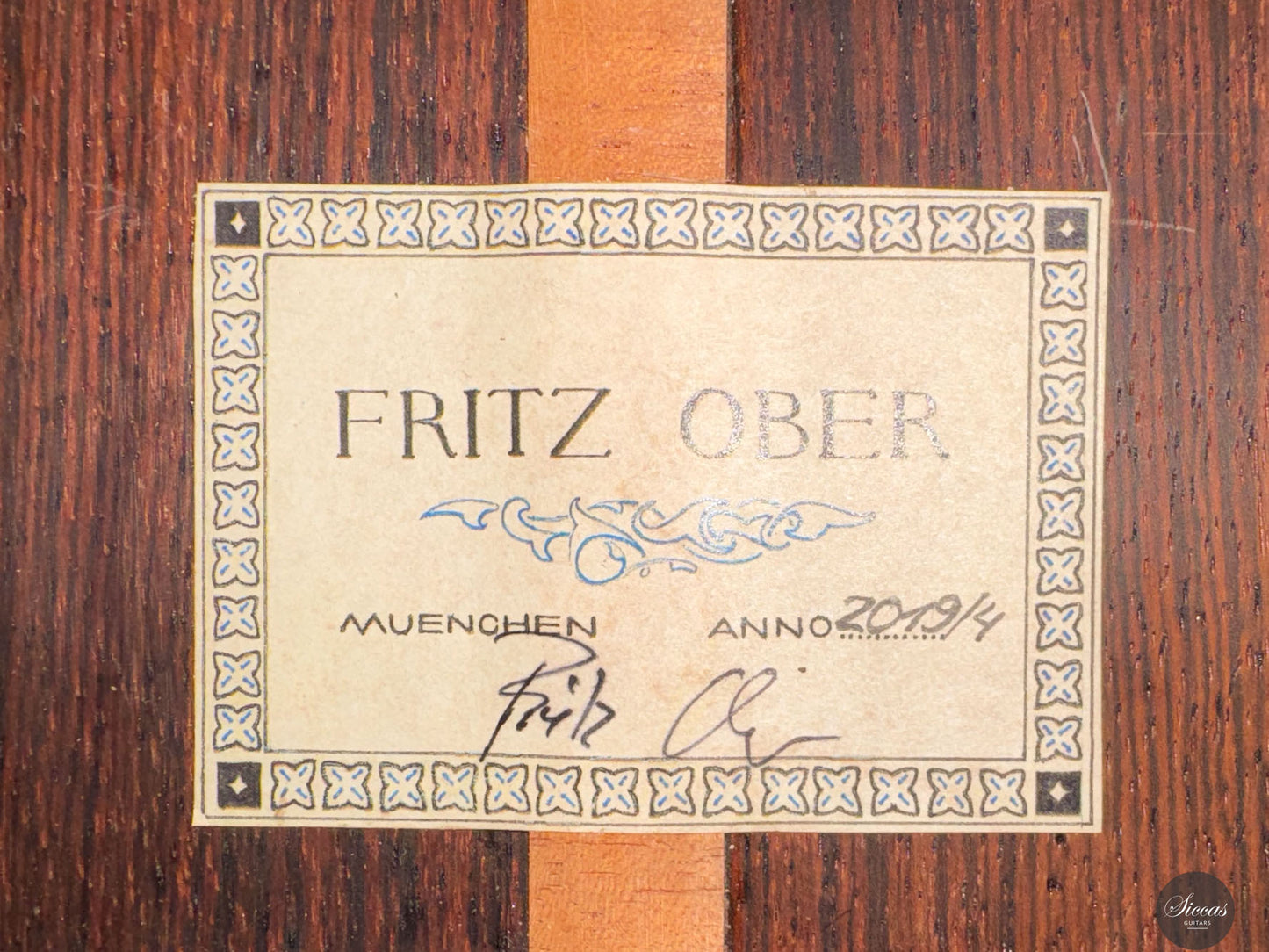Fritz Ober - 2019 - 4
Fritz Ober - 2019 - 4
Details
Details
Overview
Overview
Shipping important note
Shipping important note
Delivery times are typically reliable and most instruments arrive within the estimated timeframe.
Should any unexpected delay occur, our team will keep you informed and provide support at every step. For all shipping details and exceptions, please see our Shipping Policy.
Details about GPSR
Details about GPSR



























Video overview


More details about the guitar
About the luthier
Fritz Ober (1955–2020) was a German luthier known for his dedication to the tonal ideals of historical instruments, particularly those built by Antonio de Torres and Hermann Hauser I. He was especially drawn to guitars with deeper body profiles and lower air resonances, as found in certain Torres models. Rather than reproducing a single design, Ober developed his own interpretations that blended the tonal richness of Hauser with the deeper bass qualities of early Torres instruments. His plantilla was closely related to Hauser’s, though subtly informed by the forms of Torres and Manuel Ramírez. Among his most notable creations was a faithful reproduction of Torres’ “La Leona,” used in concert by Wulfin Lieske. He also explored techniques for achieving profound resonance without relying on devices like the tornavoz. Ober’s guitars aimed to preserve the warmth and character of traditional Spanish instruments while providing the clarity and strength in the treble needed for modern repertoire.About the guitar
This guitar, built in 2019 and numbered 4, is among the final instruments completed by Fritz Ober. It exemplifies his mature style and tonal priorities: tradition, depth, and refinement. The top is made of select spruce, with back and sides of Brazilian rosewood (CITES certified), all finished in French polish. These premium tonewoods are paired with a highly resonant body design that speaks to Ober’s Torres-inspired philosophy. One of this guitar’s most distinctive attributes is its extremely low air body resonance, measured between C♯ and D, a rare feature in traditionally built instruments and the result of Ober’s pursuit of deep, responsive voicing. Its weight is exceptionally light at just 1345 grams, which contributes to a fast, tactile response across the dynamic spectrum. The guitar delivers a smooth and lyrical first string, excellent note separation, and a sound that is both powerful and intimate, with a tonal signature that evokes older instruments while supporting modern repertoire. As the fourth guitar completed by Ober in his final year, this instrument is ideally suited to collectors seeking a piece of historical and artistic significance. At the same time, it is a superb choice for discerning players who value rare voicing, low body resonance, and subtle tonal color.Condition
The instrument is in excellent condition, with no structural repairs or cosmetic issues. The French polish is even and well preserved. The Klaus Scheller tuners function precisely. The guitar is performance-ready and exceptionally well maintained.Regular care extends the life of the instrument
Even with careful use, a classical guitar may gradually change in appearance or respond to unstable storage conditions. Have a close look at your guitar regularly and be attentif to changes. If your instrument is suffering from its environement, it will let you know.
Protect Your Guitar: Handle with Care
Be mindful when touching your instrument with greasy or unwashed hands: any skin contact is a small attack on the varnish. Of course, a guitar is made to be played, but taking a few precautions helps preserve its beauty: wash your hands before playing, wear long sleeves, and avoid unnecessary direct skin contact with the body of the instrument.
Pro tip: Avoid playing with a button-up shirt, heavy jewelry, or a belt, as these can scratch the guitar. Also, make sure your guitar case is free of any objects that could damage the instrument during storage.
String care
A good habit to adopt is wiping down your strings briefly after each playing session. This small action significantly extends their lifespan and helps maintain a consistent, comfortable feel under your fingers.
Most importantly, clean strings are essential for keeping your instrument in tune. Corrosion, sweat, and dust can affect the uniformity of the strings and interfere with accurate tuning across the entire fingerboard.
Pro tip: If you're having trouble getting your guitar in tune, it might be time to change the strings. A useful test is to compare the pitch of the 12th fret harmonic with the fretted note at the 12th fret; if there's an unusually large gap between them, your strings may have lost their integrity and should be replaced.
Keep Your Shellac Finish Shining!
Got a guitar with a shellac (French polish) finish? Here's a simple trick: Take a clean microfiber cloth and gently breathe on the surface to create a light mist. Then, softly rub to remove fingerprints, sweat, and grease. That’s usually all it takes to keep it looking great, no products needed!
Pro tip: Every few years, treat your guitar to a check-up with a luthier to keep it in top shape.
Storing Your Guitar: Climate Matters
Your guitar can safely stay outside its case, as long as the surrounding environment maintains 42–55% humidity and a temperature between 18–25°C.
Keep in mind that humidity levels can still fluctuate inside the case, especially during seasonal changes.
- Too much humidity may cause overtightened strings and a dull tone.
- Too little humidity can lead to a bulging top, string buzz, or even cracks.
Avoid placing your guitar near radiators, air conditioners, or windows with direct sunlight.
Pro tip: Always close your guitar case while playing. This helps preserve a stable microclimate inside the case, so your instrument is protected the moment you put it back in.

























































